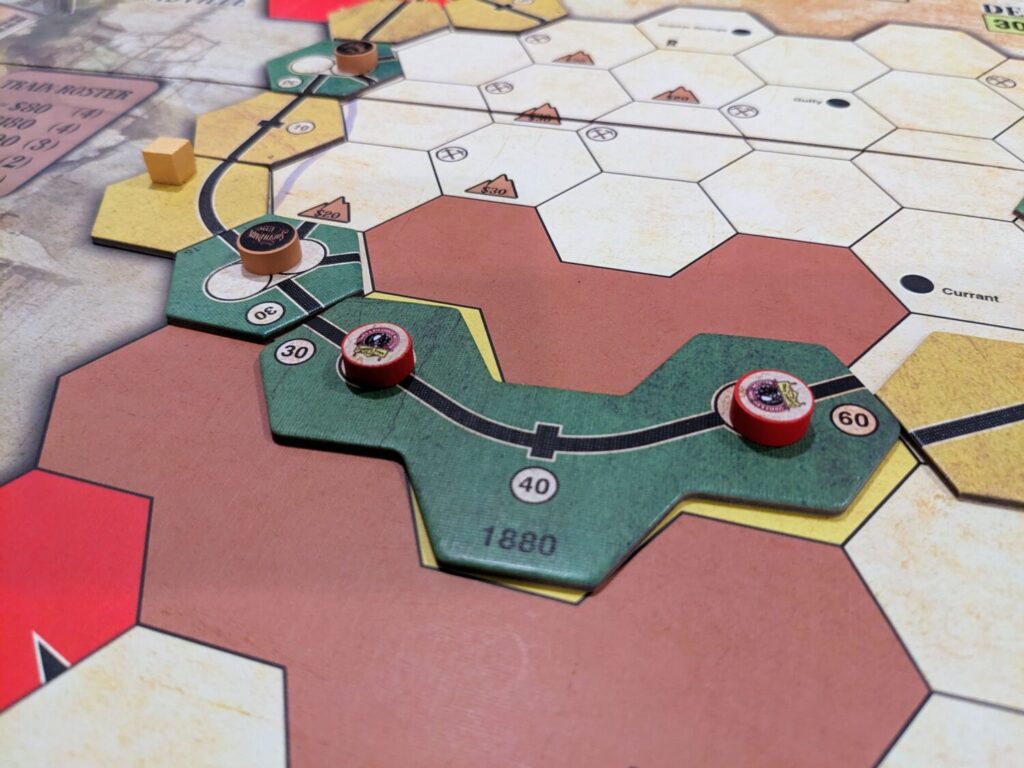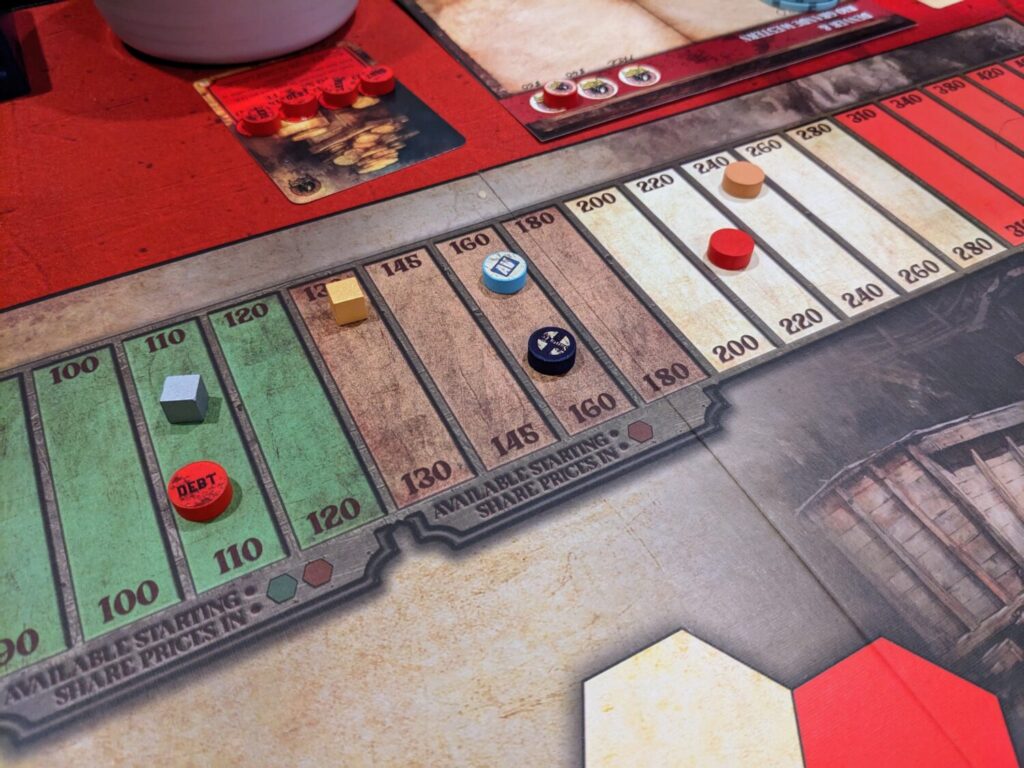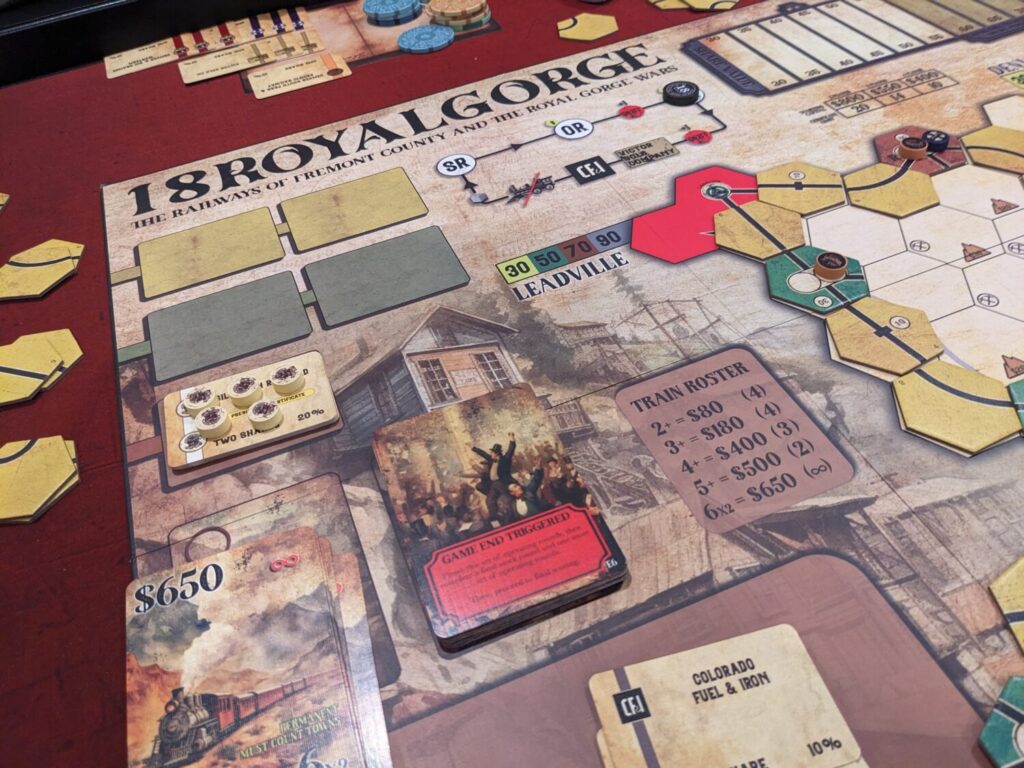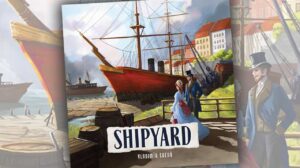Disclosure: Meeple Mountain received a free copy of this product in exchange for an honest, unbiased review. This review is not intended to be an endorsement.
Here’s the lead with the new 18xx title 18RoyalGorge: The Rails of Fremont County and the Royal Gorge Wars—it was designed by Kayla Ross (she/her) & Denman Scofield (he/him). As far as I can tell, 18RoyalGorge is the first and only 18xx title co-designed by a woman.
The surprises continued as I explored the box. 18RoyalGorge is a train game that can be played in about two hours, similar to other 18xx games such as 18MS: The Railroads Come to Mississippi, System18 or last year’s Railways of the Lost Atlas. That puts it in “weeknight train game” territory. The game is very friendly to new players (4 trains are permanent here!), has an interesting pool of private companies, and even allows players to invest in the company that is selling steel to players in order to facilitate the use of new track.
That puts 18RoyalGorge in a unique place, and that’s even before we discuss the graphic design and visual board elements designed by Scofield. I think this is a system worth exploring, as long as you approach the game with the proper frame of mind.

Wait…What’s Doc Holliday Doing Here?
18RoyalGorge is an economic, route-building simulation experience for 2-4 players. Using the 18xx system created by Francis Tresham with the games 1829 and 1830: Railways & Robber Barons, 18RoyalGorge tries its best to bring the system into the modern world of tabletop gaming. (I won’t be explaining the 18xx format in this review; if you need a primer, please check out my 18xx overview.)
The unique changes to the 18xx system start almost right away. In each game of 18RoyalGorge, only five companies are available, and two of them are always the same: the Denver & Rio Grande Western (which I will refer to as Rio Grande) and Santa Fe corporations. The other three are chosen from a pool of nine other companies at random before play begins…and even then, the order in which companies enter play is usually different, with only two of the five corporations available to par in the yellow phase, two more in green, then the final company becomes available for auction during the brown phase. (18RoyalGorge is an “incremental” capitalization game, similar to how 1846: The Race for the Midwest sets up a new company, versus a “full cap” capitalization game like most 18xx games I have played.)
In a four-player game, that automatically means that only half of the players will be able to run a corporation in the first set of operating rounds. I’m surprised to report that 18RoyalGorge is still interesting for investors in that first OR set mainly because of the existence of Colorado Fuel & Iron, the company that other train corporations have to pay to build track throughout the game. In that four-player game, one player played the investor strategy all the way until the end of the game…and won, which I have never seen happen in any other 18xx game before.
So, the investor strategy is a viable path, even if a person like me plays these kinds of games mainly to figure out the best routes to make the most money for my companies.

Other changes abound. Players can lay and/or upgrade up to six pieces of track every round. That means that in the brown phase, a player might start a new company, lay a yellow city track for their first build, then immediately upgrade it twice from yellow to green, then green to brown, for their first three track moves of their operating turn. In 18RoyalGorge, new companies get up to speed very quickly, leading to much faster transitions between rounds.
There’s also a debt system for Rio Grande and Santa Fe, with Rio Grande owing Santa Fe cash amounting to four debt payments that must slowly be made during play. If the president of Rio Grande does not pay off that debt by the end of the game, the company’s final market value can sink significantly. Santa Fe is indebted to Doc Holliday, for fun historical reasons detailed in the game’s manual.
It’s really hard to sink an opponent’s company here thanks to rules that prohibit the loss of market value when non-presidents dump shares. Trains are a part of what is ostensibly an event deck. Gold can be shipped by companies connected to certain map tiles, and some of the game’s private companies operate all the way until the end of the game, not just when the game reaches the brown phase.
18RoyalGorge is an 18xx game, but it does play around with a lot of the traditional structure in ways that surprised me. As a game free from nearly all stock shenanigans, its operational focus ends up being both its major net positive and its negatives with some of the players in my circles.

Bring New Players and Focus on the Positives
18RoyalGorge sits alongside 18MS and Railways of the Lost Atlas as the 18xx titles I am most likely to use as my onboarding ramp for new players.
That’s mainly for two reasons. It’s almost impossible to play 18RoyalGorge for more than three hours. Thanks to the small train roster and the automatic export of a train at the end of each set of ORs (including all remaining 2 trains at the end of the first set of ORs), I always found myself in the brown phase after 60-90 minutes, and play quickly moves to the gray phase within another hour, maybe less. That’s a good thing, and allowing players so many track upgrades on a single action really speeds play on its medium-sized map (it’s bigger than the map of games like 18MS, and much smaller than monstrosities like the map used for 18 India.)
The other main thing I like for new players is that it is pretty hard to murder off an opponent by dumping a company on them during the second stock round. (I did see a player try this, though, when they intentionally “train locked” their company by buying two 2+ trains for Rio Grande in the first set of ORs, hoping that someone would buy a second share of Rio Grande in order to set up the dumping ground. No one took the bait.) That means, for the most part, this is a shenanigan-free affair, and usually I find that rookies run for the hills when their first 18xx experience is getting hosed with a terrible, landlocked company in the second SR of a long game. Yes, this is what typically happens most in games like Shikoku 1889, where new players get hammered early and never recover in a 4+ hour slog.

Outside of that, 18RoyalGorge goes out of its way to be a production that appeals to Euro players who are looking for a strong rulebook and player aids (18RoyalGorge has one of the best-looking and easy-to-parse rulebooks in the 18xx family), a mostly clear board design, and something with real character. That includes the inclusion of Old West characters as private companies, like Holliday and Annie Oakley, or the inclusion of a brothel (the Madam Evens private) as a revenue-generating location that shifts for the back half of the game.
There were a number of minor items that, collectively, kept 18RoyalGorge off the top tier. The company variability ended up not being that variable over the course of my three plays (once each at two, three, and four-player counts); Rio Grande is always included in the yellow phase and usually had an easy path to build all the track it needed to get to the Royal Gorge area of the map. Silverton was only randomly drawn in my third and final play of 18RoyalGorge, and because it came out during the brown phase and has one of the worst red/”distant connection” revenues in the game, no one was elbowing their mother to become president of the weakest company that appeared in that game.
Six of the game’s 11 companies start in the northeast portion of the map, and while I didn’t try this, I would be curious to see how the game would play if the three random corporations were all in that northeast section, joining Rio Grande to create a bit of a mess in that section of the board. That would be folly, and while it may or may not play well, it would absolutely create real drama around spacing and track building. As it was, though, there was usually a good spread between having one or two companies in the center of the map, Rio Grande along the northern edge, Santa Fe in the east, and one of the western companies in each game. This is great for a newer group to ensure players have the space, but I wonder if 18RoyalGorge would be more interesting with less companies.
The people in my network who like their 18xx games to feature shenanigans didn’t enjoy 18RoyalGorge as much as I did, and I get it. The game’s rules don’t even allow players who sell shares to dent an opponent’s market value. One of my guys is a huge 1830 fan and he loves being able to tank a company to the point where shares don’t count against the certificate limit, before building companies back up. He likes trying to hose other players by starting up companies then dumping them on a poor sucker who decided to buy a second share. 1830 has, in my view, good corporations and bad ones, bad privates and great ones.
The board’s graphic design ended up being a mixed bag. I like that the board has character…but sometimes, players reacted negatively to yellow tiles that look a bit dirty, because they are a little brown to simulate the Old West themes. Sometimes, there are black numbers on dark backgrounds, or dark text used to display rules below the stock value track at the top middle of the main board. Even in a well-lit game room, 18RoyalGorge has a board that is not always easy to read, despite a stellar rulebook.

The privates roster in 18RoyalGorge is fascinating, with only five used in each game out of a pool of 25 (!!!). Some seem better than others—gosh, I loved my play with the Hanging Bridge Lease, where I was able to pay the Rio Grande owner a 10% revenue fee to use their very handsome and usually locked routes through the Royal Gorge tile. But as much as I love the variety, I think newer players will struggle when estimating the value of each private because of the speed of the phase changes. I’ve already done it myself, and I have about 200 plays logged in 18xx games (between IRL plays and my time on 18xx.games). Some of that misinterpretation will come when players realize that phases can move more quickly than in other 18xx titles. On its own, I don’t think of this as a negative, but it is noteworthy.
I didn’t enjoy my play of 18RoyalGorge at two players, although I generally think I like my train games with more people anyway. For the most part, the two of us did whatever we wanted in that game, and the lack of tension hurt the overall product. Again, I find this is the case each time I do a two-player 18xx game…the map is too open, it’s too easy to get shares or the companies I want to run, there are basically no shenanigans, etc.
In that four-player game, we used the game’s short variant, which essentially ends the game before players really get the chance to see their earning potential with the 6×2 trains (six stops, double revenue payouts). My advice is to always play the whole game out normally, to ensure that a few people get to taste the sweet fruit of potential $1,000 runs in the final set of operative rounds. (3x bumps are possible here.)
18RoyalGorge is a solid first-design from the team at 18Wood, and its differences are meaningful in a category that continues to get a little more crowded each year. I like having a few 18xx games in the weeknight train game quiver, so 18RoyalGorge will live on as a potential solution for those game nights.











